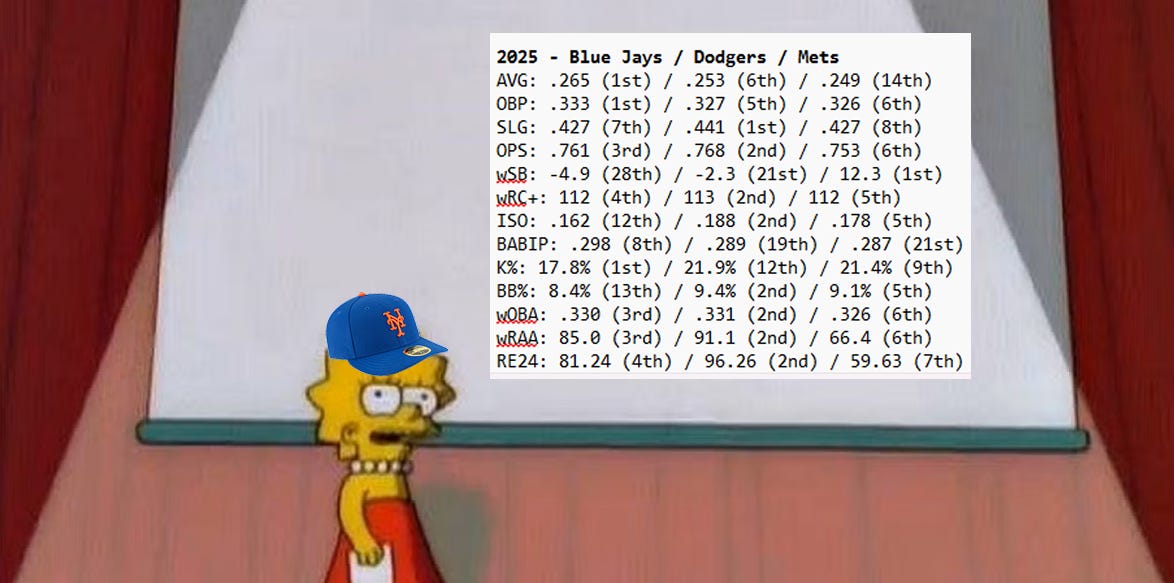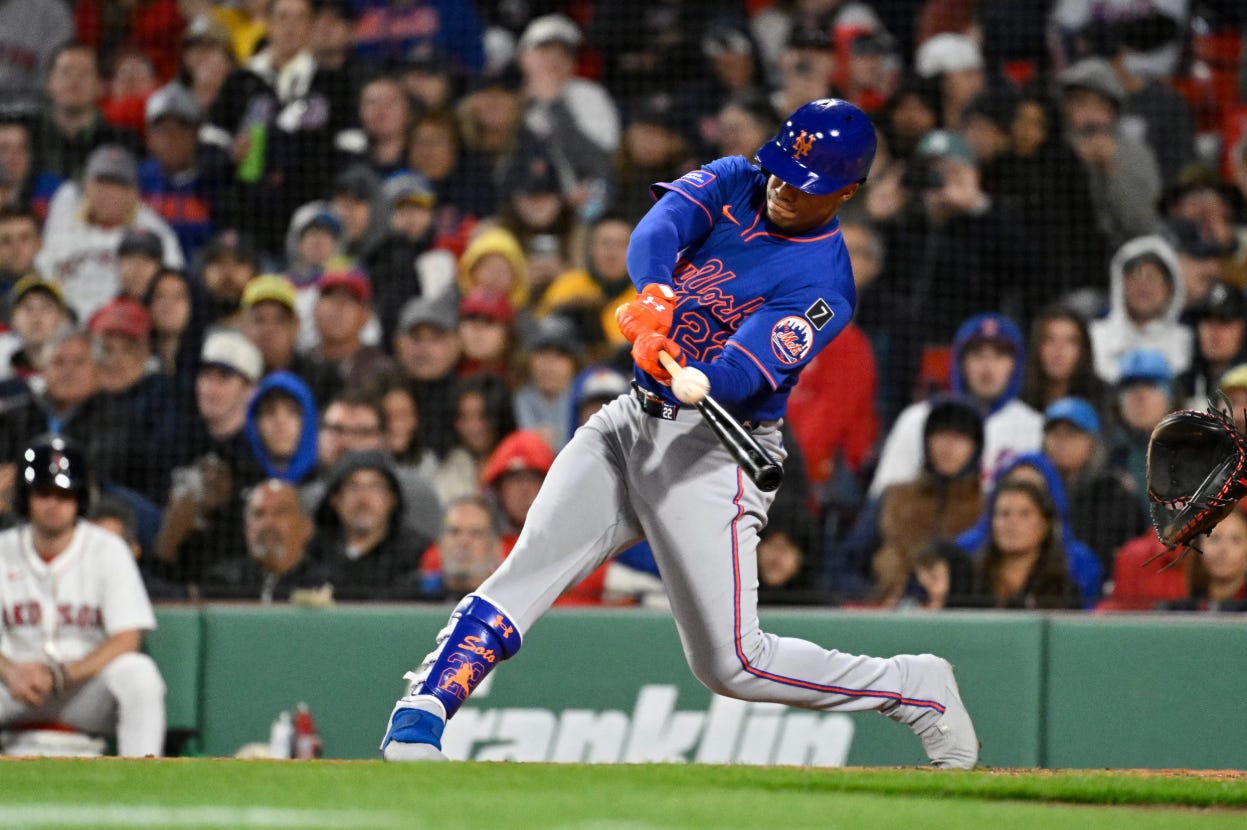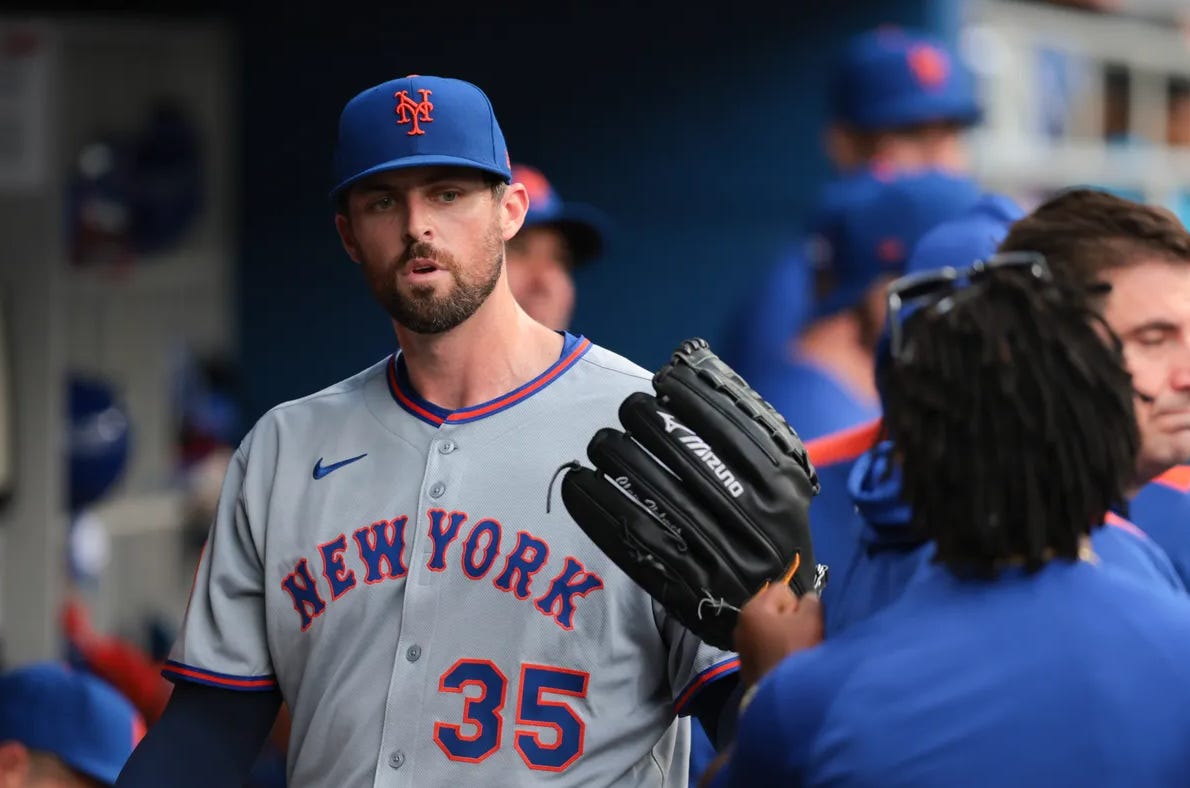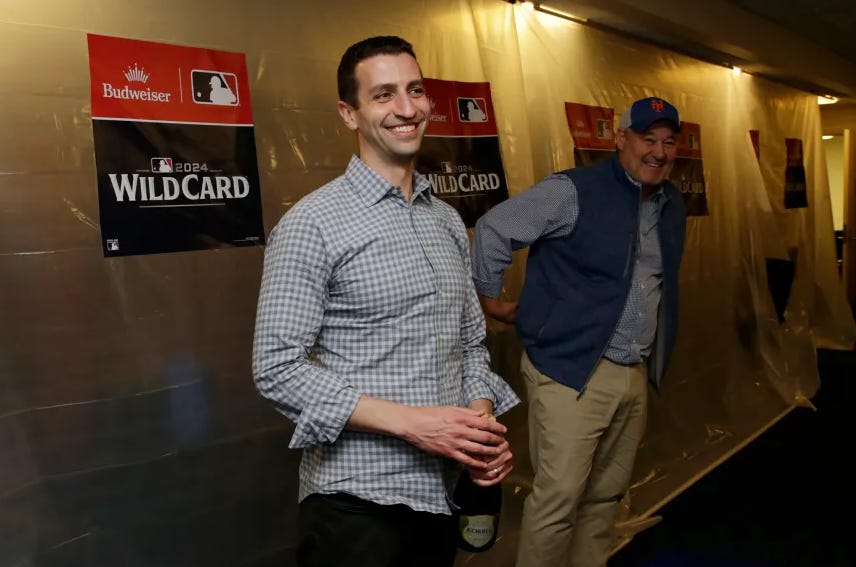What's the best way to win a championship?
The secret to constructing a true contender may actually lie more in run creation* than prevention...
When the Toronto Blue Jays and Los Angeles Dodgers advanced to the 2025 Fall Classic, baseball viewers everywhere were promised the privilege of watching the league’s two best offenses duke it out on the national stage. Naturally, I was curious to see if any obvious statistical trends would emerge over the course of the series; maybe these two teams can passively impart some lessons onto Mets brass that can help inform roster construction in 2026.
However, so far, only one remaining team has truly shown up to play.
Through these first five games, the Blue Jays have played almost exactly to their per-162 statistical standard, while the Dodgers have fallen painfully below their regular-season thresholds. Here’s where each pennant-winning offense stood entering the postseason, plus the Mets’ season line for comparison:
TOR 2025: .265/.333/.427, .761 OPS, 17.8 K%-8.4 BB%, .162 ISO, .298 BABIP, -4.9 wSB, .330 wOBA, 112 wRC+, 85.0 wRAA, 81.24 RE24
LAD 2025: .253/.327/.441, .768 OPS, 21.9 K%-9.4 BB%, .188 ISO, .289 BABIP, -2.3 wSB, .331 wOBA, 113 wRC+, 91.1 wRAA, 96.26 RE24
NYM 2025: .249/.326/.427, .753 OPS, 21.4 K%-9.1 BB%, .178 ISO, .287 BABIP, 12.3 wSB, .326 wOBA, 112 wRC+, 66.4 wRAA, 59.63 RE24
On the surface, the Mets’ offense doesn’t look like it was much of a problem — and to a point, that’s true. They kept pace with the AL and NL champs in terms of basic slash line, OPS, K-BB%, ISO, BABIP, wOBA, and wRC+. However, we know from painful experience how little of the story those surface stats actually tell. (More on that shortly.)
Now, let’s look at the World Series slash lines:
TOR World Series: .261/.341/.389, .730 OPS, 19.0 K%-9.5 BB%, .128 ISO, .297 BABIP, -0.6 wSB, .317 wOBA, 105 wRC+, 1.0 wRAA, 2.69 RE24
LAD World Series: .201/.296/.354, .651 OPS, 25.3 K%-11.1 BB%, .153 ISO, .236 BABIP, -0.5 wSB, .279 wOBA, 79 wRC+, -5.5 wRAA, -8.30 RE24
Huh…quite the performance discrepancy from LA.
While the Dodgers’ pitching staff hit a historic stride that had many people (including yours truly) convinced that overachieving arms would ultimately win the series, I’ve generally always believed that getting on base and maximizing scoring opportunities is the ultimate key to winning any series, let alone the World Series. After running the numbers on the last 10 teams to win the whole thing and comparing their metrics to this season’s contenders, that remains true. The Jays have continued to create runs at their expected frequency of output; the Dodgers…have not.
This may come as a surprise, but among the most recent World Series winners, elite slugging and pitching haven’t been reliable predictors of success. Rather, the true harbingers of good things to come can be found lurking in the deep data.
All but two World Series champions in the past decade have ranked in the top 7 in advanced run creation metrics like weighted on-base average (wOBA) and weighted runs above average (wRAA). These two stats are excellent indicators of whether an offense is a well-rounded run producer or a boom-or-bust collection of big boppers. wOBA credits every offensive action (walks, singles, doubles, etc.) based on its true run contribution, and wRAA converts that value into a raw number of runs generated above the league average player.
Still, while wOBA and wRAA are helpful and important in telling the story of a player’s or team’s offensive season, they only give you so much information, as they’re context-neutral. A lineup can have a great group wOBA, but the team will still lose close games if it fails to score in high-leverage spots (sound familiar?)
That’s where even deeper data joins the party.
In baseball, context is everything. It goes without saying that not all hits are created equal: a bases-empty, two-out single in the second inning and a bases-loaded, two-out single in the seventh carry vastly different levels of influence on win probability. Enter: RE24.
RE24 (Run Expectancy for 24 Base-Out States) is a context-dependent statistic that measures the change in the team’s expected run total for the rest of that inning, based on the 24 possible combinations of base runners and outs. Those combinations come from the eight ways the bases can be occupied (empty, runner on first, runners on first and second, etc.) multiplied by the three possible out counts (0, 1, or 2). Each of those 24 situations has an expected number of runs that are typically scored from that point forward.
Essentially, RE24 rewards hitters for delivering the ‘right’ outcome at the ‘right’ time. A player gets a hit, and depending on the in-game situation, RE24 tracks how the hitter’s action changes that moment’s run expectation. For example, Juan Soto led the Mets this year with a 51.84 RE24; that would mean his plate appearances were worth about 52 more runs than would have been created by the average player in the same situations.
Let’s see how the Mets stacked up against the Dodgers and Blue Jays in regular-season RE24 in 2025:
Dodgers: 96.26 (2nd)
Blue Jays: 81.24 (4th)
Mets: 59.63 (7th)
When looking at RE24 among recent World Series champions, their consistent proficiency in this area is impossible to ignore; eight of the last 10 champions ranked top 5 in RE24, and all of them were top-10 in the league in their championship season. Only the 2021 Braves and 2022 Astros won the World Series with a team RE24 of under 70; half of them posted marks of at least 120. So, while the Mets just barely squeaked into a top 10 position, relative to what we’ve established as a theorized recipe for success, they were actually lagging quite a bit behind their contemporaries in the run expectancy department.
It’s also noteworthy that, though there’s often a power correlation, RE24 doesn’t always directly align with slugging or ISO rankings. This is a testament to the limit of power value, as your team’s ability to deliver a big hit semi-regularly doesn’t guarantee it will also deliver runs in optimal situations.
And speaking of situational hitting and power…while the Mets’ overall power metrics kept pace with top offenses like the Dodgers and Blue Jays, you don’t need me to remind you how bad the Mets were with runners aboard.
Specifically, though the Mets matched the Jays and Dodgers in regular-season XBH total, New York also delivered 30 fewer singles than LA and nearly 100 fewer hits than Toronto with runners on base. While matching the power output of the league’s top units is something to strive for, that power output also clearly didn’t push enough runs across the plate to put the Mets in a position to contend. Those missing hits, scaled across a full season, represent an enormous loss of expected runs.
Ok, so a well-rounded, efficient offense is the cornerstone of a championship — feels obvious enough. But where do pitching and defense factor in?
Looking at the numbers, the necessity of a top pitching staff to win the World Series is surprisingly overstated when compared to that of a consistent offense. Some recent World Series winners have done so with rotations that ranked as low as 15th in the league in regular-season ERA and/or FIP. That’s not to say good pitching and a solid bullpen aren’t important, by any means — they are. They’re just not as crucial a piece to the championship puzzle as one might think.
Rather, the multiple champions that lacked a consensus Top-5 rotation compensated by relying on two things: reliable depth and, you guessed it, consistent run support.
As for the relevance of defense to the championship equation, the data shows significant fluctuation in how frequently a stalwart defensive club wins the title. It needs to be at least average to be functional, and having a top-rated unit is an obvious plus, but recent history hasn’t shown defense being a make-or-break factor here, at least not in the way run creation is.
So, what does David Stearns do with all the info I just dumped? We all remember how clear he was that “run prevention” will be a “point of emphasis” this winter. While plugging defensive holes and fortifying the pitching staff are certainly crucial moves for reinforcing our foundation, the established championship blueprint suggests that increasing run creation* from this roster is arguably as important as anything else. And that could mean some incredibly unpopular decisions are on the horizon.
In the spirit of the holiday, let’s address the very scary elephant in the room: losing Pete Alonso is a possibility this winter. It would mean instantly losing 40+ homers and 100+ RBIs per season; that’s incredibly difficult to replace, if not impossible, both on the field and in the locker room. However, if we are speaking purely analytically, and taking Stearns’ commitment to improvement at face value…letting Alonso go and making a move for someone like Josh Naylor makes a lot of sense for this club’s future.
If we were to reduce their value strictly down to their stats, Alonso posted a 27.63 RE24 mark in 2025, while Naylor posted a 32.89 mark across both teams he played for. Alonso directly provided 30 more homers and 30 more RBIs to the Mets’ run total, but Naylor brought run creation value in the form of base-stealing, a higher on-base rate, and vastly better defensive range to his teams. While the loss incurred by Pete’s departure would be beyond significant, adding a player like Naylor that offers new value outside the batter’s box that was previously missing may, in fact, be the move this team needs to make most, especially as its offensive identity continues to evolve.
This isn’t me saying I’m rooting for Pete to go anywhere; I’m not, at all. All I’m saying is that the heat is definitely cranked in the front office, and if Stearns and Cohen are feeling the pressure to bounce back in a big way next year, I wouldn’t be shocked to see something so seismic.
On paper, the Mets were solid enough last year, but they will need to be much better next year if they want to contend seriously. I’m equally curious and nervous to see what side of the game Stearns actually prioritizes when signing time comes.







Insightful piece. Thanks for this. I’ve never heard of RE24. Is this a new metric or have I just been missing it? Situational hitting was a big gap for the Mets in ‘25. Our eyes told us this and RE24 proves it. Hopefully the new hitting coach can make some adjustments to their approaches. That said, I bet the Mets RE24 was exceptional in 2024, even without Soto anchoring the lineup. Same coaches…
Very interesting piece and it takes gonads to suggest an alternative to Alonso, even if proposed as a thought experiment. It's a pleasure to read a writer that doesn't jump on the in vogue "run prevention" bandwagon. I wouldn't go over 4 years for Alonso. Bet you 5 years from now Alonso is hitting .205. Now, friend Buskirk, yer back to blathering "incredible"...3 times. Have pity on my sensitive ears and try "impressive", "astonishing", "remarkable", etcetera.